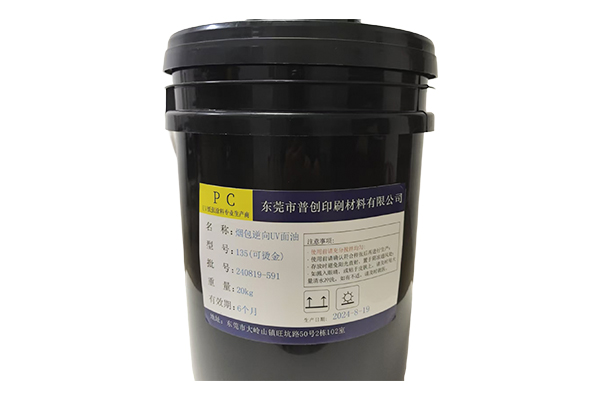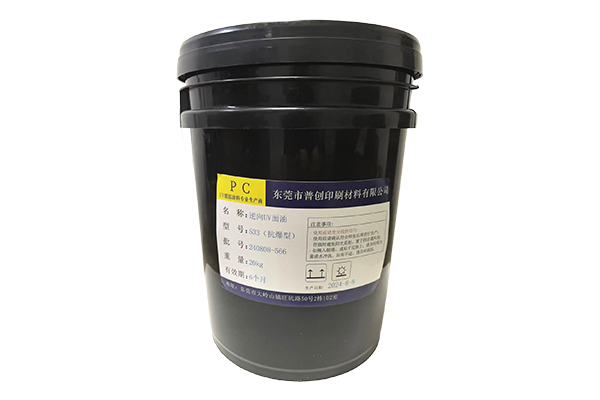How does the high hardness of reverse UV primer help improve the scratch resistance of the coating?
Release Time : 2025-08-07
The high hardness of reverse UV primer provides a solid foundation for the coating's scratch resistance. This property enables the primer layer to form a robust structure, effectively protecting against friction and impact from external objects. During daily use and processing, painted surfaces inevitably come into contact with various hard objects. If the primer is not sufficiently hard, it can easily scratch or dent the coating, compromising its overall integrity and aesthetics. The high hardness of reverse UV primer, however, leverages its inherent structural strength to reduce damage to the coating, providing reliable protection for the entire coating system.
The high hardness of reverse UV primer allows it to assume the primary responsibility for scratch resistance within the coating system, alleviating the stress on the topcoat. A coating system typically consists of a primer and a topcoat. As the foundational layer, the hardness of the primer directly impacts the overall scratch resistance of the coating. The high hardness of reverse UV primer allows it to initially withstand frictional stress when an object contacts the surface, reducing the transfer of stress to the topcoat and preventing scratches in the topcoat caused by direct force. This layered protection significantly enhances the scratch resistance of the entire coating system and extends the coating's aesthetic lifespan.
During the coating process, the high hardness of reverse UV primer helps it form a denser structure, reducing porosity and defects within the coating, thereby improving scratch resistance. Conventional primers may have tiny pores or uneven areas after curing. These weak spots can easily become scratching points when subjected to friction. However, reverse UV primer, thanks to its high hardness, creates a denser and more uniform structure after curing, reducing these weak spots. This allows the coating surface to distribute external forces more evenly, reducing the likelihood of scratches caused by localized excessive stress.
The high hardness also strengthens the bond between reverse UV primer and the substrate, indirectly improving the coating's scratch resistance. When the primer is firmly bonded to the substrate, even if the surface is subjected to friction or impact, it is less likely to peel off, thus preventing extensive scratch damage caused by coating detachment. The high hardness of reverse UV primer forms a stable interface with the substrate after curing, reducing loosening or displacement of the coating under stress, ensuring more durable and reliable scratch protection.
For painted surfaces that require frequent cleaning or wiping, reverse UV primer's high hardness effectively resists abrasive damage during cleaning. During routine maintenance, repeated friction between cleaning tools and the coating can easily cause fine scratches, which, over time, can affect surface gloss. The high hardness of the primer layer can withstand this repeated friction, minimizing scratches during cleaning, maintaining the coating's smoothness and aesthetics, and reducing the risk of damage from improper maintenance.
The high hardness of reverse UV primer allows it to better adapt to complex operating environments and enhance the coating's scratch resistance in harsh conditions. In industrial production or outdoor use, painted surfaces may come into contact with hard particles such as sand, dust, and metal debris. The collision and friction of these particles can easily cause scratches on the coating. The high hardness of reverse UV primer protects against these particles, reducing the likelihood of surface scratches, ensuring that the coating maintains its excellent appearance and performance in a variety of challenging environments, and extending the coating's service life.
Furthermore, the high hardness enhances the coating's overall wear resistance, creating a synergistic effect with its scratch resistance. Improved wear resistance means the coating can better resist various forms of wear and tear during long-term use, including scratches, friction, and collisions, thereby reducing the accumulation of surface damage. Reverse UV Primer's high hardness gives the coating a stronger wear-resistant foundation, allowing the entire coating system to maintain excellent scratch resistance during long-term use, reducing the need for repairs or recoating due to coating damage and lowering the cost of use.
The high hardness of reverse UV primer allows it to assume the primary responsibility for scratch resistance within the coating system, alleviating the stress on the topcoat. A coating system typically consists of a primer and a topcoat. As the foundational layer, the hardness of the primer directly impacts the overall scratch resistance of the coating. The high hardness of reverse UV primer allows it to initially withstand frictional stress when an object contacts the surface, reducing the transfer of stress to the topcoat and preventing scratches in the topcoat caused by direct force. This layered protection significantly enhances the scratch resistance of the entire coating system and extends the coating's aesthetic lifespan.
During the coating process, the high hardness of reverse UV primer helps it form a denser structure, reducing porosity and defects within the coating, thereby improving scratch resistance. Conventional primers may have tiny pores or uneven areas after curing. These weak spots can easily become scratching points when subjected to friction. However, reverse UV primer, thanks to its high hardness, creates a denser and more uniform structure after curing, reducing these weak spots. This allows the coating surface to distribute external forces more evenly, reducing the likelihood of scratches caused by localized excessive stress.
The high hardness also strengthens the bond between reverse UV primer and the substrate, indirectly improving the coating's scratch resistance. When the primer is firmly bonded to the substrate, even if the surface is subjected to friction or impact, it is less likely to peel off, thus preventing extensive scratch damage caused by coating detachment. The high hardness of reverse UV primer forms a stable interface with the substrate after curing, reducing loosening or displacement of the coating under stress, ensuring more durable and reliable scratch protection.
For painted surfaces that require frequent cleaning or wiping, reverse UV primer's high hardness effectively resists abrasive damage during cleaning. During routine maintenance, repeated friction between cleaning tools and the coating can easily cause fine scratches, which, over time, can affect surface gloss. The high hardness of the primer layer can withstand this repeated friction, minimizing scratches during cleaning, maintaining the coating's smoothness and aesthetics, and reducing the risk of damage from improper maintenance.
The high hardness of reverse UV primer allows it to better adapt to complex operating environments and enhance the coating's scratch resistance in harsh conditions. In industrial production or outdoor use, painted surfaces may come into contact with hard particles such as sand, dust, and metal debris. The collision and friction of these particles can easily cause scratches on the coating. The high hardness of reverse UV primer protects against these particles, reducing the likelihood of surface scratches, ensuring that the coating maintains its excellent appearance and performance in a variety of challenging environments, and extending the coating's service life.
Furthermore, the high hardness enhances the coating's overall wear resistance, creating a synergistic effect with its scratch resistance. Improved wear resistance means the coating can better resist various forms of wear and tear during long-term use, including scratches, friction, and collisions, thereby reducing the accumulation of surface damage. Reverse UV Primer's high hardness gives the coating a stronger wear-resistant foundation, allowing the entire coating system to maintain excellent scratch resistance during long-term use, reducing the need for repairs or recoating due to coating damage and lowering the cost of use.






